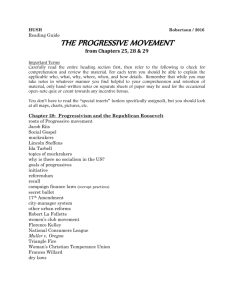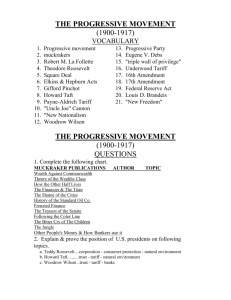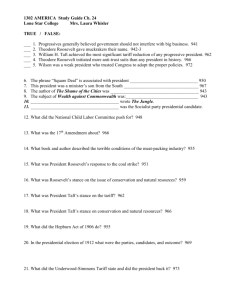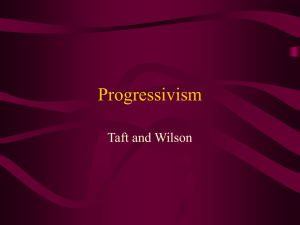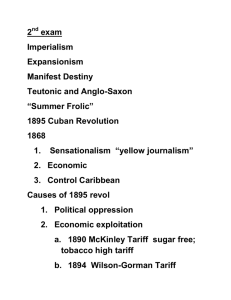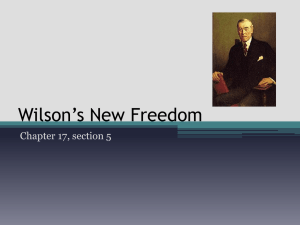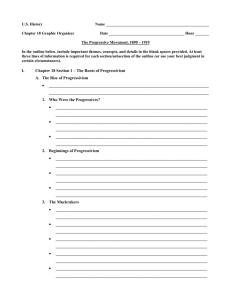Chapter 20: The Progressive Era, 1900-1917
advertisement
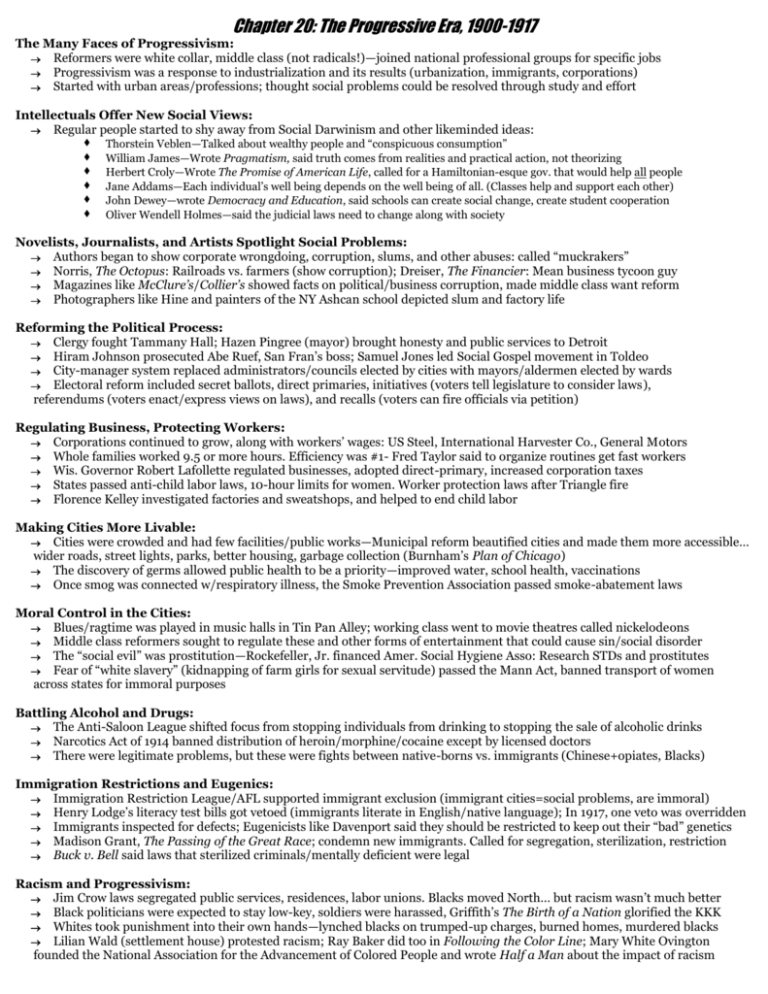
Chapter 20: The Progressive Era, 1900-1917 The Many Faces of Progressivism: Reformers were white collar, middle class (not radicals!)—joined national professional groups for specific jobs Progressivism was a response to industrialization and its results (urbanization, immigrants, corporations) Started with urban areas/professions; thought social problems could be resolved through study and effort Intellectuals Offer New Social Views: Regular people started to shy away from Social Darwinism and other likeminded ideas: Thorstein Veblen—Talked about wealthy people and “conspicuous consumption” William James—Wrote Pragmatism, said truth comes from realities and practical action, not theorizing Herbert Croly—Wrote The Promise of American Life, called for a Hamiltonian-esque gov. that would help all people Jane Addams—Each individual’s well being depends on the well being of all. (Classes help and support each other) John Dewey—wrote Democracy and Education, said schools can create social change, create student cooperation Oliver Wendell Holmes—said the judicial laws need to change along with society Novelists, Journalists, and Artists Spotlight Social Problems: Authors began to show corporate wrongdoing, corruption, slums, and other abuses: called “muckrakers” Norris, The Octopus: Railroads vs. farmers (show corruption); Dreiser, The Financier: Mean business tycoon guy Magazines like McClure’s/Collier’s showed facts on political/business corruption, made middle class want reform Photographers like Hine and painters of the NY Ashcan school depicted slum and factory life Reforming the Political Process: Clergy fought Tammany Hall; Hazen Pingree (mayor) brought honesty and public services to Detroit Hiram Johnson prosecuted Abe Ruef, San Fran’s boss; Samuel Jones led Social Gospel movement in Toldeo City-manager system replaced administrators/councils elected by cities with mayors/aldermen elected by wards Electoral reform included secret ballots, direct primaries, initiatives (voters tell legislature to consider laws), referendums (voters enact/express views on laws), and recalls (voters can fire officials via petition) Regulating Business, Protecting Workers: Corporations continued to grow, along with workers’ wages: US Steel, International Harvester Co., General Motors Whole families worked 9.5 or more hours. Efficiency was #1- Fred Taylor said to organize routines get fast workers Wis. Governor Robert Lafollette regulated businesses, adopted direct-primary, increased corporation taxes States passed anti-child labor laws, 10-hour limits for women. Worker protection laws after Triangle fire Florence Kelley investigated factories and sweatshops, and helped to end child labor Making Cities More Livable: Cities were crowded and had few facilities/public works—Municipal reform beautified cities and made them more accessible… wider roads, street lights, parks, better housing, garbage collection (Burnham’s Plan of Chicago) The discovery of germs allowed public health to be a priority—improved water, school health, vaccinations Once smog was connected w/respiratory illness, the Smoke Prevention Association passed smoke-abatement laws Moral Control in the Cities: Blues/ragtime was played in music halls in Tin Pan Alley; working class went to movie theatres called nickelodeons Middle class reformers sought to regulate these and other forms of entertainment that could cause sin/social disorder The “social evil” was prostitution—Rockefeller, Jr. financed Amer. Social Hygiene Asso: Research STDs and prostitutes Fear of “white slavery” (kidnapping of farm girls for sexual servitude) passed the Mann Act, banned transport of women across states for immoral purposes Battling Alcohol and Drugs: The Anti-Saloon League shifted focus from stopping individuals from drinking to stopping the sale of alcoholic drinks Narcotics Act of 1914 banned distribution of heroin/morphine/cocaine except by licensed doctors There were legitimate problems, but these were fights between native-borns vs. immigrants (Chinese+opiates, Blacks) Immigration Restrictions and Eugenics: Immigration Restriction League/AFL supported immigrant exclusion (immigrant cities=social problems, are immoral) Henry Lodge’s literacy test bills got vetoed (immigrants literate in English/native language); In 1917, one veto was overridden Immigrants inspected for defects; Eugenicists like Davenport said they should be restricted to keep out their “bad” genetics Madison Grant, The Passing of the Great Race; condemn new immigrants. Called for segregation, sterilization, restriction Buck v. Bell said laws that sterilized criminals/mentally deficient were legal Racism and Progressivism: Jim Crow laws segregated public services, residences, labor unions. Blacks moved North… but racism wasn’t much better Black politicians were expected to stay low-key, soldiers were harassed, Griffith’s The Birth of a Nation glorified the KKK Whites took punishment into their own hands—lynched blacks on trumped-up charges, burned homes, murdered blacks Lilian Wald (settlement house) protested racism; Ray Baker did too in Following the Color Line; Mary White Ovington founded the National Association for the Advancement of Colored People and wrote Half a Man about the impact of racism African-American Leaders Organize Against Racism: Booker T. Washington- accommodate racism; W.E.B Du Bois- demanded equality and full black resistance Ida Wells-Barnett wrote A Red Record; fought against lynching and racism Villard, Du Bois, and others of the “Niagara Movement” started National Association for the Advancement of Colored People Revival of the Woman-Suffrage Movement: Wyoming, Utah, Colorado, Idaho, and California were the first five to gain women’s suffrage National American Woman Suffrage Asso. Under Carrie Chapman Catt used “Winning Plan”—grassroots, strict central control Suffragists lobbied, put up posters, parades; “Antis” said women had behind-the-scenes influence and didn’t need any more Alice Paul founded Congressional Union for Women Suffrage to enact a national suffrage amendment, targeted Democrats Enlarging “Woman’s Sphere”: Charlotte Perkins Gilman wanted to widen woman’s sphere: labor equality, collectivized domestic tasks. Wrote Herland BIRTH CONTROL ADVOCATES: Margaret Sanger: The Woman Rebel/Birth Control Review Direct action, physicians supply Mary Ware Dennett: The Sex Side of Life Lobbying, widespread distribution Workers Organize; Socialism Advances: Danbury Hatters case forbade unions from organizing boycotts to support strikes Industrial Workers of the World union (Wobblies) led by Haywood; Socialists like Eugene V. Debs sought to end capitalism Roosevelt’s Path to the White House: Roosevelt, a Republican progressivist, took over after McKinley’s assassination. He was outgoing, a “cowboy”, Jingoistic Labor Disputes, Trustbusting, Railroad Regulation: TR was halfway pro-labor: often sided with management, like in miners’ strike, but sometimes used troops Thought corporations need to be regulated: attorney general dissolved the Northern Securities company, a railroading trust GOP nominated Roosevelt, adopted probusiness platform, won; Democrats nominated Alton Parker, embraced gold standard Consumer Protection: Upton Sinclair wrote The Jungle, which showed gross conditions in meat plants Pure Food/Drug Act: banned unclean food, required labels; Meat Inspection Act: Rules for meatpackers, federal inspections Environmentalism Progressive-Style: Summer camp, boy/girl scouts gave children a taste of wilderness; Pinchot was the first leader of the US Forest Service TR supported the National Reclamation Act; gave money from land sales to water management- setting up dams & irrigation AKA the Newlands Act… it created Roosevelt Dam in AZ, dams in Snake River, ID. Made farmers that benefit from this pay up TR set aside lots of land as national forests before this right was evoked in 1907. National Park Service was made 9 years later The Antiquities Act protected archaelogical sites, especially in the Southewst Sierra Club tried and failed to save the Hetch Hetchy Valley in Yosemite from the building of a dam Taft in the White House, 1909-1913: William Howard Taft, Republican, won in 1909, supported Mann-Elkins Act, which strengthened the ICC The insurgents were Repubs who wanted low tariffs; Taft ticked them off by passing the Payne-Aldrich tariff Ballinger of Ballinger-Pinchot tariff was anti-conservation, gave out land in AK for coal, fired those who spoke out against him TR returned and campaigned for Insurgents; Democrats and Insurgents controlled the House and Senate by 1910 The Four-Way Election of 1912: TR and Taft wanted to run, but Taft controlled political machines and disqualified TR’s delegates; TR’s supporters left and formed the Progressive Party Election was TR with Progressive, Taft with Repubs, Woodrow Wilson with Dems, Eugene Debs with Socialists. Wilson won! Tariff and Banking Reform: Wilson passed Underwood-Simmons tariff, lowered taxes Federal Reserve Act created 12 private/public banks that could issue US $. Controlled by bank leaders, Federal Reserve Board Regulating Business; Aiding Workers and Farmers: Federal Trade Commission made to watch corporations: investigate rule violations, require regular reports Clayton Antitrust Act spelled out specific illegal business practices that could lead to lawsuits Keating-Owen Act, Adamson Act, Workmen’s Compensation Act, Federal Farm Loan Act, Federal Warehouse Act, Federal Highway Act (see bottom page) Progressivism and the Constitution: Louis Brandeis gave lots of evidence documenting the effects of long hours on working women, was elected to Supreme Court 1916, Wilson Edges Out Hughes: Wilson renominated for Dems, Charles Evans Hughes for Repubs, Progressives supported Hughes; Wilson won again! Legislation Year Act 1902 National Reclamation Act Hepburn Act 1906 Pure Food/Drug Act Meat Inspection Act Antiquities Act 1909 Payne-Aldrich Tariff Mann Act 1910 Mann-Elkins Act Underwood-Simmons Tariff 1913 Federal Reserve Act Federal Trade 1914 Commission Act Clayton Antitrust Act Narcotics Act Federal Farm Loan Act/Warehouse Act Keating-Owen Act 1916 Adamson Act Workmen’s Compensation Act Federal Highway Act Provisions Funds dams and irrigation in West Regulates railroad rates Labeling/cleanliness requirements Federal inspections for meatpackers Protects Southwestern archaeology Raises tariffs, splits Repubs Anti-prostitution- can’t transport women for immoral reasons Strengthens I.C.C Lowers tariffs Creates Fed. Banks that could issue US dollars, ruled by individual bank leaders and the Fed. Reserve Board Creates FTC as watchdog agency over corporations Specifies illegal business practices Forbids addictive drugs not prescribed by doctor Farmers get low-interest federal loans from land/crops as collateral Bans products made by child labor from interstate trade 8-hour workday for interstate railroad workers Provides injury protection for federal workers Feds give money for state highway programs Court Rulings 1904 Northern Securities 1906 Lochner v. New York 1908 Muller v. Oregon 1911 Standard Oil Co v. US 1927 Buck v. Bell Antitrust suit against Northern Securities, a railroad company Overturns NY law setting maximum working hours for bakery workers Upholds OR law setting maximum working hours for female laundry workers Orders dissolution of Standard Oil Upholds Virginia sterilization law Amendments Sixteenth Seventeenth 1919 Eighteenth 1920 Nineteenth 1913 Congress can impose income tax Direct election of senators by voters Prohibits manufacture/sale of alcoholic drinks Grants women’s suffrage
